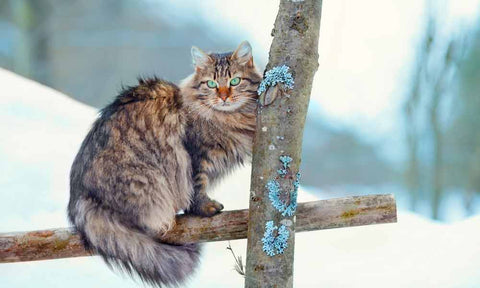Is our number one priority
Siberian Forest

Athletic cat from Russia
Origin
The Siberian Forest is a rare cat breed that comes from Siberia. It is also known simply as Siberian. This breed is believed to have been brought to Siberia by Russian emigrants.
This cat has a glamorous long thick coat that protected it from the sub arctic climate of the forest area of the Taiga, Siberia.
This breed was one of the three long-haired cats represented at the first exhibition held in England in the 18th century.
Breeder Elizabeth Terrell in Louisiana was responsible for bringing the Siberian Forest to America. It has not yet received full acceptance from cat breeders because it is a rare breed, but it is gaining popularity.
Characteristics
Siberian is a big strong cat with powerful muscles. He has a moderately long shaped body with a well rounded chest.
This cat has a broad head, in the form of a modified wedge. He has a rounded muzzle with long whiskers.
The Siberian Forest has large wide eyes that are almost round in shape. Eye color is not related to coat color. The ears are medium sized.
The legs are moderately long with the hind legs longer than the front legs. The rounded paws have toe tufts and the tail is long and thick with long hairs hanging down from the top.
The Siberian's coat is moderately long. It is slightly shorter in the shoulder blades and some parts of the chest. The Siberian cat will shed once or twice a year. The long triple coat has cover hair, AWN hair and a downy undercoat.
The coat is water-repellent and the undercoat is greasy. The fur comes in different colors and patterns with the exception of pointed colors.
Siberian Forest takes five years to mature. Adult females weigh less than males.
The lifespan of a Siberian Forest is 12 - 15 years.
Temperament
Siberian is loving and playful. Despite his large size, he is very agile with a big jump. He can easily jump on top of cupboards and shelves.
This cat loves people and can follow his human companion around. He is a "lap cat" and enjoys being petted and cuddled. He gets along well with new people, other feline friendly pets and children too.
Siberian Forest can learn tricks as he is intelligent and a good problem solver. Fetching and playing with a good cat toy are ways to keep him active and challenged.
This cat came from the Siberian forest, so he loves to play in water. He can even jump in the bathtub with his human companion.
He is not clingy and can adapt to any type of home environment, including apartment living.
Grooming and fur care
Although the Siberian Forest is long-haired, he does not require much maintenance. His coat is easy to care for and does not tangle or knot. Weekly brushing is more than enough. During periods of shedding, it is advisable to brush and comb the coat every day to remove dead hair and prevent the formation of knots.
At shows, the Siberian Forest must be given a bath before each event, otherwise the cat can settle for a bath three or four times a year.
The ears should be cleaned weekly to check for any inflammation or bad smell. The teeth must be cleaned regularly with an approved toothpaste and toothbrush. This will promote good overall health and fresh breath.
Trimming nails may be necessary to keep them short and neat. A good scratching post will also help them wear naturally.